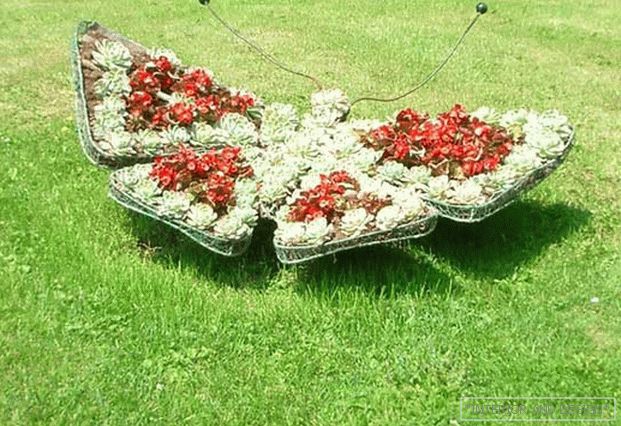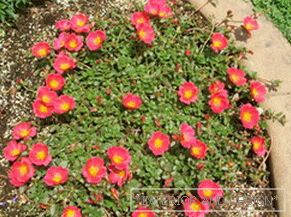 Quite often in the suburban areas you can meet purslane, which is a fairly common element of landscape design. During growth, it forms a large green carpet, which is why it has been used as ground cover plants.
Quite often in the suburban areas you can meet purslane, which is a fairly common element of landscape design. During growth, it forms a large green carpet, which is why it has been used as ground cover plants.
First of all, it is placed on the most lighted areas. Often it can be found on dry soils, where he plays the role of a lawn substitute. This plant is quite unpretentious, and therefore can grow well on rocky soils. Thanks to portulaca, you can form a floral carpet that can cover both smooth slopes and slopes.
This element can be found in the composition of the most diverse elements of landscape design: in rockeries, on stone walls, in rabatkah, and also on the slopes of the alpine hills. Often the purslane is a constituent of the flower garden, where it can be a good substitute for faded ornithic gums, muscari and other small-bulbous plants whose flowering period begins in spring. Often this plant is included in mixborders, where it participates in the formation of the foreground. It can also be planted in arid places where it serves as a border plant.
Being quite unpretentious plant, purslane can be grown in special forms, such as hanging vases. In addition, balconies and balconies are suitable for its growth and development.
Content
- 1 Types of portulaca
- 1.1 Portulac grandiflora
- 1.2 Garden purslane
- 2 Growing and caring for purslane
- 3 Conclusion
Types of portulaca
In the wild, a plant such as purslane is quite widespread and includes about 200 species. At the same time, there are very few cultivated varieties - only two of them.
Portulac grandiflora
In the wild, this purslane can grow more than one year, but in our country it is grown in flower beds only as an annual plant, since no measures can protect it from severe frosts. This type of plant has a low stem and is characterized by a creeping structure, the leaves of this type of purslane are cylindrical, and the diameter can reach up to 2 cm.
More often The following varieties are found:
-
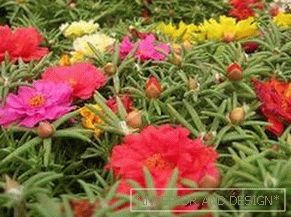 Scarlet. This variety has a small height of up to 12 cm and a strongly branched stem. In the process of growth forms terry flowers of scarlet color, the diameter of which does not exceed 5 cm. The plant begins to bloom in July until mid-October;
Scarlet. This variety has a small height of up to 12 cm and a strongly branched stem. In the process of growth forms terry flowers of scarlet color, the diameter of which does not exceed 5 cm. The plant begins to bloom in July until mid-October; - Cherry This variety belongs to the category of undersized and has ordinary cherry flowers that can reach up to 5 cm in diameter;
- Hybrid "Cream". The plant is distinguished by the presence of double flowers, the diameter of which can reach 5 cm, usually cream-colored, which become more saturated as they get closer to the center;
- Splendex. This plant is distinguished by the presence of pink-purple flowers;
- Sunglo. This variety can not boast of large sizes of its flowers, but it can bloom even in cloudy weather;
- Orange. The name of the variety already indicates that its flowers have a bright orange shade. Usually he is assigned in beds the role of ampelous plants.
Garden purslane
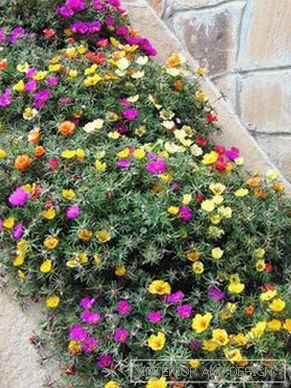 This type of purslane is often known as dandur or flea plant. Due to the fact that it can grow on almost any soil and with minimal attention from the summer resident, many owners have a negative attitude to this type of purslane, which they associate with a difficult-to-remove weed. This type of purslane is characterized by the presence of a fleshy, bare, juicy stem, whose shoots are crimson in color and can reach a length of 60 cm. The latter tend to lie on the ground, only the growing part of the purslane is in an elevated state.
This type of purslane is often known as dandur or flea plant. Due to the fact that it can grow on almost any soil and with minimal attention from the summer resident, many owners have a negative attitude to this type of purslane, which they associate with a difficult-to-remove weed. This type of purslane is characterized by the presence of a fleshy, bare, juicy stem, whose shoots are crimson in color and can reach a length of 60 cm. The latter tend to lie on the ground, only the growing part of the purslane is in an elevated state.
The photo clearly shows that the plant has a yellowish-green or completely green leaves that stand out fleshy, pawed or oblong-oval. This plant begins to bloom in June until September. However, it is not recommended to use this type of portulaca for decorative purposes, for the reason that the yellow flowers of the plant have shapeless and small enough.
Even in ancient times, people knew about the healing properties of purslane. First of all, leaves and shoots of a plant are considered valuable, as they contain a large number of useful substances:
- vitamins A, E, C, PP, K;
- easily digestible proteins;
- carbohydrates;
- carotene;
- organic acids;
- saponins;
- mineral and mucous salts.
Purslane is known in folk medicine due to its wound healing, anti-inflammatory and diuretic properties. Drugs created on its basis are capable of remove inflammation in the bladderas well as relief from kidney and liver diseases, as well as arthritis and eye diseases. Portulaca juice is also healing, which can be achieved by lowering blood sugar and cholesterol levels.
In addition to its healing properties, purslane has been used in cooking. First of all, this refers to the green succulent shoots, the harvesting of which is carried out before the beginning of flowering. When adding a plant to various dishes, the latter acquire a sour, refreshing taste, which is complemented by mild and spicy nuances. This manifests the similarity of portulaca with such known plants as sorrel or spinach.
Portulak, whose photo is presented on the network, is enough common planton the basis of which they make salads. It is also used as an additive in vegetable dishes, gravies and sauces to fish and meat dishes. It can often be found on the table of the peoples of the Caucasus and Central Asia, who use it in pickled and salted. In addition, purslane is harvested and dried.
The presence of good illumination is a prerequisite for the reason that in periods of no bad weather or when plants are placed in shaded places, the flowers cannot open. If the plant receives very little light, it is highly likely that the purslane will not start blooming at all. If such unfavorable conditions are created for him, this will lead to a lengthening of the stem, and the carpet itself will no longer look monolithic.
Soil
The most suitable for planting portulaca is sandy soil. But it is not recommended to plant it on too fat land because it will start the process when the plant spends all its efforts to build up green mass, because of which the owner may not wait for flowering to begin. Be sure to take care of the absence of peat in the soil. If heavy soil was chosen for planting portulaca, then before the seeds fall into the ground, it must be fertilized with charcoal.
Top dressing
During the entire vegetative period, plants can do without additional feeding, therefore the purslane feels quite comfortable on poor soil. If fertilizers are applied, then plants may stop blooming because of this.
Watering
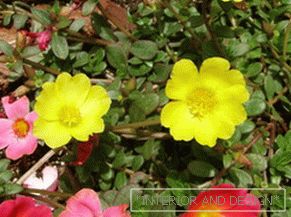 Plants respond well to water, so purslane must be watered well not only after transplantation, but also during active growth. But gradually it is necessary to reduce the amount of water. Although as the fleshy leaves of purslane develop, they can accumulate water, without periodic watering by an adult plant it will be difficult to grow. Therefore, it is usually enough to water the plants once a week. During periods of drought, the frequency of irrigation is increased to once every 3-4 days.
Plants respond well to water, so purslane must be watered well not only after transplantation, but also during active growth. But gradually it is necessary to reduce the amount of water. Although as the fleshy leaves of purslane develop, they can accumulate water, without periodic watering by an adult plant it will be difficult to grow. Therefore, it is usually enough to water the plants once a week. During periods of drought, the frequency of irrigation is increased to once every 3-4 days.
Portulaca care
Photos can only describe the external signs, and because of them it is impossible to know that purslank belongs to unpretentious plants, which significantly simplifies the care of him. The owner of the suburban area will be spared the need to carry out such familiar operations as weeding, loosening the soil and pruning.
Diseases and pests
As a rule, purslane is well protected from various diseases. However, there are still situations where the plant can get sick. This usually causes the fungus Albugo portulaceae, whose activity causes the appearance of small specks on the leaves of plants. As the disease progresses, the leaves change their shape and become less attractive.
To combat this fungus is necessary:
- remove affected plant parts;
- the remaining shoots spray fungicidal preparations, which include copper.
Quite rare is the phenomenon when purslane is affected by thrips, which means insect pests that cause damage to plants due to sucking the juice. Signs of their presence is the appearance of silvery specks on the leaves.
Portulaca reproduction
 More often растения размножаются семенами. Одна из особенностей портулака — коробочки, в которых находятся семена, созревают неравномерно. Поэтому при полном созревании происходит их растрескивание. Чтобы избежать подобного, семена необходимо собирать в недозрелом состоянии, после чего их выкладывают на бумагу для дозревания. Обычно семена остаются пригодными для посадки на протяжении двух-трех лет. Однако все же не рекомендуется выдерживать столь длительную паузу и при наличии прошлогодних семян лучше сразу же использовать их для нового посева.
More often растения размножаются семенами. Одна из особенностей портулака — коробочки, в которых находятся семена, созревают неравномерно. Поэтому при полном созревании происходит их растрескивание. Чтобы избежать подобного, семена необходимо собирать в недозрелом состоянии, после чего их выкладывают на бумагу для дозревания. Обычно семена остаются пригодными для посадки на протяжении двух-трех лет. Однако все же не рекомендуется выдерживать столь длительную паузу и при наличии прошлогодних семян лучше сразу же использовать их для нового посева.
The first flowers of the plant appear already after 2-2.5 months after germination. For this reason, seedlings should be sown in early March. Having prepared the container of the required size, it is filled with a drainage layer of no more than 1 cm. Usually fine gravel is used. The main fertile layer is formed from garden soil and sand, which are taken in the ratio of 80% and 20%. It should be borne in mind that if peat is in the ground, it will worsen germination. Moreover, there are cases when not a single germ appeared on such a ground.
After thorough watering of the land with thawed or separated water, seeds are sown from above, and then a covering material, such as a film, is placed on the container. Already after 5-15 days the first shoots appear. After waiting for this moment, the film can be removed. Over the coming weeks, you need to water the seedlings, using a spray bottle. This should be done until the plants are strong.
Bearing in mind that purslane belongs to heat-loving plants, it is recommended to maintain temperature at a level of + 22 degrees Celsius. By providing a temperature of up to + 30 degrees Celsius, you can improve plant growth. When a month has passed since the emergence of the seedlings and the plants will have several true leaves, they will pick the seedlings into small pots with a diameter of 7-8 cm.
Conclusion
A plant such as purslane can often be found at the dacha plots. First of all, it is interesting for summer residents because of its unpretentiousness. And although there are no special difficulties in the process of caring for this plant, there are certain nuances that can affect the quality of portulac flowering. Therefore, it is necessary to approach not only correctly the choice of a place for planting these plants, but also the composition of the soil, which ultimately can affect whether the plants can bloom and how long it will last.



